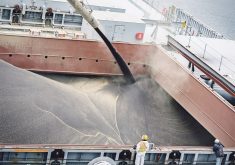Farmers might market fewer classes and grades of wheat in a post-monopoly world.
Economists and industry players expect the wide waterfront of Canadian Wheat Board wheat divisions to narrow once the board no longer controls the huge western Canadian crop.
“The wheat board was obligated to take this grain from farmers. A grain company is not,” said agricultural economist Ed Tyrchniewicz.
“My guess is that there will be pressure to simplify the grading system.”
Canada’s grain system has many wheat divisions by class and grade, far more than most other countries.
Read Also

Russian wheat exports start to pick up the pace
Russia has had a slow start for its 2025-26 wheat export program, but the pace is starting to pick up and that is a bearish factor for prices.
Experts say that is because the CWB takes control of a vast western Canadian wheat crop and can identify exact amounts of product it has to sell.
Even small amounts of specific qualities and grades can be marketed by a large agency that can combine shipments from many sources.
However, some analysts say grain companies in an open market will not be able to be sure of supplies that they haven’t yet bought.
As well, they might not know for sure how much of any specific class and quality they can safely contract to a buyer.
They also might not want to handle so many different divisions of wheat because it makes grain handling more complex and less efficient.
With less security of supply and a high cost of handling small quantities of specific types, companies will probably want to handle fewer, larger divisions of wheat.
“There will probably be fewer segregations in the system just because they will be less affordable,” said University of Saskatchewan agricultural economist Richard Gray.
University of Manitoba Transport Institute analyst Paul Earl told the recent Fields on Wheels conference in Winnipeg that wheat divisions might become simpler, but wheat would always be a more complex commodity because its end uses are more complex.
Wheat millers have more specialized needs than the one simple standard on which crops like lentils and canola are built.
Cam Dahl, a former Canadian Grain Commission commissioner, said a post-monopoly grain system will see farmers contracted to grow specialized wheat.
“I think you’re going to see more contracts like the Warburton’s contract, where you have specific mills and buyers in other countries … contracting for specific varieties,” said Dahl.
Wheat marketing could become more complex and variety specific, which is not common now.
Barry Senft, a former Canadian International Grains Institute head and former vice-president of Saskatchewan Wheat Pool, said buyers and processors will have the biggest impact on what grain companies choose to buy from farmers.
“Canada will be tailoring the wheat to fit that particular customer,” said Senft. “It depends what the customer wants.”
The CWB is now required to move all the non-feed wheat that farmers produce. It tries to encourage them to grow types of wheat that buyers want and will pay for, but has to market the grain regardless.
However, after the monopoly disappears, no one will be forced to move wheat types or grades for which there isn’t a strong demand or can’t be moved easily.
Tyrchniewicz said farmers will need to check with grain companies and marketers about what buyers want them to produce.
He also said grain companies will push for the grain commission to drop micro-divisions of quality because they add little value but add much complexity to grain storage and handling.
Many farmers prefer multiple wheat divisions because it allows the CWB to obtain premiums for providing buyers with specialized products, but others wish wheat was less onerous to store, market and move.
Regardless of what farmers want, Tyrchniewicz thinks grain companies will push hard to make wheat less of a drag on their systems. Other commodities move with far greater efficiency and less cost.
“Other grain grading systems in wheat are much, much less complicated,” said Tyrchniewicz. “I think it can be simplified. If other countries can simplify it, why can’t we?”
MORNINGSIDE, Alta. – Coyotes are opportunistic, intelligent and adaptable to urban and rural areas. The more contact they have with people, the less fear they show.
As a result, phones at municipal offices are ringing off the hook with complaints about coyote problems throughout Alberta.
“My typical calls are in spring calving or in the early fall,” said Dion Burlock, agriculture fieldman with Lacombe County.
The lamb flock is growing in the province, as is the number of complaints about coyotes, he told a producer workshop about predators that have developed a taste for Alberta lamb and beef.
More complaints are expected as Alberta’s population spreads into traditional wildlife habitat.
“As Alberta grows and our acreages expand and as we bring more people into the rural area that really don’t have a background in farming or living on the land, places like Calgary have a lot more problems than we did in the past,” said Greg McKinnon, a professional trapper who works with livestock producers.
Coyotes are listed as a pest under provincial law, and counties can supply poison to producers who have confirmed kills on their property.
However, Ken Wick of Alberta Agriculture said poison should be a last resort.
Coyotes are excellent hunters but will also eat whatever is available.
Parents teach their young how to scavenge and hunt, which tells McKinnon that they can be trained to stay away from certain areas.
As well, the animals’ relentless nature means farmers and ranchers cannot give up from one year to the next.
“The adults teach the young what is acceptable and what isn’t,” he said.
“You can train coyotes to stay away and you have to use every tool at your disposal, whether it is shooting them, whether it is fences or the dogs. Your main focus is to teach those bad coyotes this is unacceptable.… One bad coyote will cause you a lot of grief.”
Wick said producers also have to take responsibility to protect their investment.
He advises cleaning up garbage around the farmyard, removing dead animals and afterbirth from lambing and calving areas and installing and maintaining fences.
Guard dogs that live with the flock work well, as do llamas, donkeys or a horse trained to hate dogs.
“Dogs are the best non-lethal coyote control,” said Wick.
Electric fences may not be enough of a deterrent.
“Coyotes are so smart it doesn’t take them long to figure it out.”
Producers need a defendable perimeter around their farms, especially in spring when young animals are born.
“Every time you see a coyote inside your perimeter, you have to drive him out,” McKinnon said.
They will travel up to eight kilometres from the den, and not all are troublesome.
“You should focus on the problem animal, not the species, because you are not going to wipe out coyotes,” he said.
Producers might also consider hiring a professional trapper who understands predators and has the best tools to eliminate them in a fast and humane way.
McKinnon would like to see a pilot program launched where trappers and producers work together on predator control.
“Trappers study and understand the animal and they use their knowledge of the animal in order to capture it,” he said.
McKinnon is a retired RCMP member who has been trapping since he was 10 years old. He teaches a 27 hour course to trappers based on a 400 page manual. He prefers modern foothold traps over snares or poison to avoid killing the wrong animals.
He uses a foothold trap that does not mangle or cut off the blood supply. Coyotes usually travel at night, which means it’s important to check traps first thing in the morning. That way animals won’t be caught for too long and the trapper can shoot them and salvage their pelts.
These traps are easy to set up, but it is harder to trick coyotes into stepping on them.
McKinnon digs a small hole and drives two metal stakes into the ground to secure the trap, which is carefully buried with a light covering of soil and grass.
The bait is set 25 centimetres behind the trap, which a coyote steps into with its front foot when sniffing the bait.
Mid fall is the best time to set traps because young coyotes are still relatively naive.
Neck snares are spring loaded, unbreakable wire. It is hard to kill them this way because coyotes have tough neck muscles.
Snaring also requires a trapper’s permit from the sustainable resource development department’s fish and wildlife division.
There are 3,000 trappers in the province, who can be contacted through the Alberta Trappers Association.















